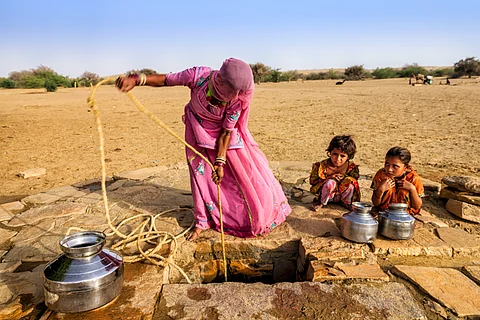

On World Environment Day 2025, as governments and corporations tout green pledges, a quieter truth demands attention: Women across the globe — and particularly in climate-vulnerable countries like India — are bearing the brunt of a crisis they did little to cause.
A growing body of research has highlighted that women disproportionately bear the brunt of its devastating impacts. From heatwaves and floods to air thick with pollution, the effects of environmental degradation fall hardest on women, compounding longstanding inequalities, deepening economic precarity and fuelling a shadow crisis of gender-based violence.
Globally, studies consistently show that natural disasters, encompassing floods, droughts, heatwaves and storms, often result in higher mortality rates among women, who are also more susceptible to injuries. This vulnerability stems from long-standing gender inequalities that limit their access to crucial information, mobility and resources. Traditional caregiving roles can delay women’s personal evacuation as they prioritise the safety of children and the elderly, while disruptions to essential services like water and sanitation amplify their already heavy domestic burden.
A particularly alarming consequence is the documented increase in gender-based violence, including sexual violence, harassment and harmful practices such as early marriage, in the wake of disasters. Economic instability, resource scarcity and the breakdown of social structures exacerbate existing power imbalances, making women and girls more vulnerable to exploitation. Research has indicated a direct link between extreme weather events and spikes in early marriage rates, for instance.
Beyond acute events, climate change acts as a “threat multiplier,” intensifying food and water insecurity, increasing displacement risks and adding to women’s caregiving responsibilities. Their often limited access to land ownership, credit and participation in climate-related decision-making bodies further hinders their ability to adapt effectively.
The psychological toll of climate change, including increased stress and anxiety stemming from environmental hazards and uncertainty, also disproportionately affects women.
In India, a nation highly vulnerable to climate change, extreme weather events are increasingly frequent and intense, with women facing severe consequences. In rural areas, where women are often responsible for water collection, heatwaves and droughts lead to longer, more arduous journeys to distant water sources, increasing their exposure to extreme heat and the risk of heatstroke.
Floods, intensified by climate change, create conditions conducive to waterborne diseases and pose significant challenges for women’s sanitation and menstrual hygiene.
Concerningly, specific research in India has established a link between drought conditions and an increase in intimate partner violence (IPV), with similar associations found for cyclones and emotional IPV. The economic shocks from crop failures and resource scarcity can lead to increased deprivation and conflict within households, manifesting as violence against women.
Furthermore, the “feminisation of agriculture” in India sees an increasing number of women taking on farming responsibilities due to male out-migration. Despite their growing role, women farmers often lack secure land ownership rights, access to crucial credit and essential agricultural resources, making them particularly susceptible to climate-related losses.
Women’s limited representation in climate-related decision-making processes further compounds these vulnerabilities, alongside direct threats to women's reproductive health, including adverse pregnancy outcomes.
Air pollution presents another major, gendered health risk. Globally, traditional gender roles often dictate that women are primarily responsible for household chores like cooking and heating, frequently involving the use of solid fuels like wood and coal.
This practice leads to much higher levels of exposure to household air pollution for women compared to men, particularly in low- and middle-income countries. The World Health Organization has highlighted that in poorly ventilated dwellings, indoor smoke can reach levels of fine particulate matter hundreds of times higher than acceptable.
Exposure to air pollution has been consistently linked to an increased risk of various maternal health complications, including stillbirth, miscarriage and preterm birth. Emerging evidence also points towards a connection between air pollution exposure and an elevated risk of hypertension and other chronic diseases in women.
Indian women face a dual burden, exposed to both high levels of indoor air pollution from traditional cooking practices and alarmingly high levels of ambient air pollution in cities and rural areas. This combined exposure contributes to a range of adverse health outcomes, including respiratory illnesses like asthma and chronic obstructive pulmonary disease (COPD). Maternal exposure to high levels of air pollution during pregnancy is also linked to low birth weight in newborns and impaired lung development in offspring.
Underlying these pervasive impacts are several critical themes. The interconnectedness of environmental factors means that climate change can worsen air quality, creating compounding health challenges. Crucially, pre-existing gender inequalities – in access to resources, information, education and decision-making – fundamentally amplify women's vulnerability to environmental stressors.
Physiological differences also play a role, with women more susceptible to heatstroke and pregnancy creating vulnerabilities to pollutants. Finally, an intersectional approach is vital, recognising that women’s experiences are shaped by socioeconomic status, caste, ethnicity and other identities, leading to compounded disadvantages for marginalised groups.
The evidence is clear: Women bear a disproportionate burden of environmental change. Addressing this requires gender-sensitive climate policies that ensure women’s meaningful participation in decision-making at all levels of governance. Integrating gender considerations into disaster risk reduction, prioritising access to clean and affordable energy solutions in households and strengthening healthcare systems to meet women's specific needs are crucial steps.
Furthermore, targeted programmes to address and prevent gender-based violence in the context of environmental change, alongside continued investment in research with sex-disaggregated data, are essential to build a more equitable and sustainable future in the face of our changing planet.